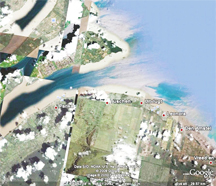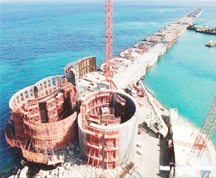Peter R. Ramsaroop, MBA
Good gubby nah ah float ah tap. (Good things don’t come easily.) Guyanese Proverb
Introduction
Infrastructure is to a nation what blood vessels are to a living being. Just as our blood vessels carry vital nutrients to every cell in our body, so does a nation’s infrastructure make transport possible – whether the transport of physical goods, energy or information. If a person’s circulatory system were unable to do its work properly, one might sit in the midst of paradisiacal abundance and yet starve. In a sense, that is the situation that Guyana finds itself in today. Although work has been done on the main roads as an example, access roads to villages and farms remain in dire need of improvement. A rice farmer without an all-weather access road can take hours to get to the rice fields as is the case in West Berbice.

Freeing the infrastructure logjam – deep water harbour

The need for a deep water harbour was first introduced to the public by Stanley Ming, Eric Phillips and Kads Khan in the late 90s with the Guyana 21 plan. This was also added in the National Development Strategy (NDS). We continue to push aggressively for this project to get started by the government. The PPP administration finally in 2006 copied this item to its manifesto but has done nothing to move the project forward. The President, in his 2010 New Year message said this is the year of infrastructure and I hope he didn’t mean fixing the same roads they did last year, but that a deep-water harbour is in the top 3 of all projects. We continue to support this initiative as a key component in turning our economy around and creating prosperity for our citizens.
The best place for the deep water harbour is at the mouth of the mighty Essequibo River.
In addition Hog Island in the Essequibo can function as an Export Processing Zone (EPZ) where domestic taxes and other obligations are minimized thus encouraging private investments in small, medium and large companies.

The picture of a harbour construction is from a French Engineer who is currently in Guyana. He was one of the main architects of a deep water harbour in North Africa. The purpose of the picture is to show that such a construction project is very possible here also. The cost for such a project can run to in excess of US$200 million. One alternative is to build a large river port in Georgetown that run into the Atlantic Ocean as a faster alternative until monies are available for a deep water harbour.
Benefits
The highway to Brazil must also be completed for this project to realize the most benefits. Ships to and from Asia and North America to Northern Brazil can port at a deep water harbour in Guyana and goods will get to Northern Brazil and further south by trucks and rail saving almost 6-8 days.
One of the key reasons for the Hog Island site for the export processing zone, is that it is part of shifting our major infrastructure and economic activity off our increasingly flood prone below sea level coastal plains. In addition a deep water harbour also allows for the larger cruise liners to dock in Guyana giving our eco-tourism industry a significant boost.
Like present-day Guyana, Suriname suffers from high shipping costs due to the absence of a deep water harbour. When we construct a deep water harbour this would lead to a substantial lowering of import costs and will stimulate greater export activity through the availability of roll-on/roll off facilities and high-speed goods transfer systems.
Imagine the new jobs that would be created, from construction, harbour logistics, shipping technology, tourism, manufacturing, ship maintenance, and engineering, easier availability to markets, etc.
Conclusion
We need to be bold in Guyana and create the conditions to encourage large investments in the country’s infrastructure which include partnerships with the private sector, neighbouring countries and the multilateral banks. This requires a government with a vision for the development of all Guyana and hence it requires that we work on changing the current government. It’s our “Guyanese Dream” to have prosperity, therefore believe that the dreams described in this column are truly realistic goals–when we dare to envision them and actualize them. Let’s make them a reality. Until next time “Roop”
Send comments to peter.ramsaroop@gmail.com




